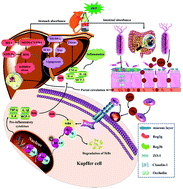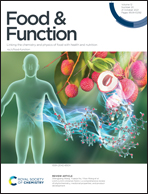Oligopeptides from Jinhua ham prevent alcohol-induced liver damage by regulating intestinal homeostasis and oxidative stress in mice†
Abstract
The current study aimed to evaluate the protective activity of peptides isolated from Jinhua ham (JHP) against alcoholic liver disease (ALD) and the mechanisms by which JHP prevents against ALD. The tangential flow filtration (TFF) combined with size exclusion chromatography (SEC) and reversed-phase high performance liquid chromatography (RP-HPLC) were used to isolate the JHP. Then the hepatoprotective activity of peptides was evaluated through experiments in mice. The primary structure of the peptide with the strongest liver protective activity was Lys-Arg-Gln-Lys-Tyr-Asp (KRQKYD) and the peptide was derived from the myosin of Jinhua ham, which were both identified by LC-MS/MS. Furthermore, the mechanism of KRQKYD prevention against ALD was attributed to the fact that KRQKYD increases the abundance of Akkermansia muciniphila in the gut and decreases the abundance of Proteobacteria (especially Escherichia_Shigella). The LPS-mediated liver inflammatory cascade was reduced by protecting the intestinal barrier, increasing the tight connection of intestinal epithelial cells and reducing the level of LPS in the portal venous circulation. KRQKYD could inhibit the production of ROS by upregulating the expression of the NRF2/HO-1 antioxidant defense system and by reducing oxidative stress injury in liver cells. This study can provide a theoretical foundation for the application of JHP in the protection of liver from ALD.



 Please wait while we load your content...
Please wait while we load your content...